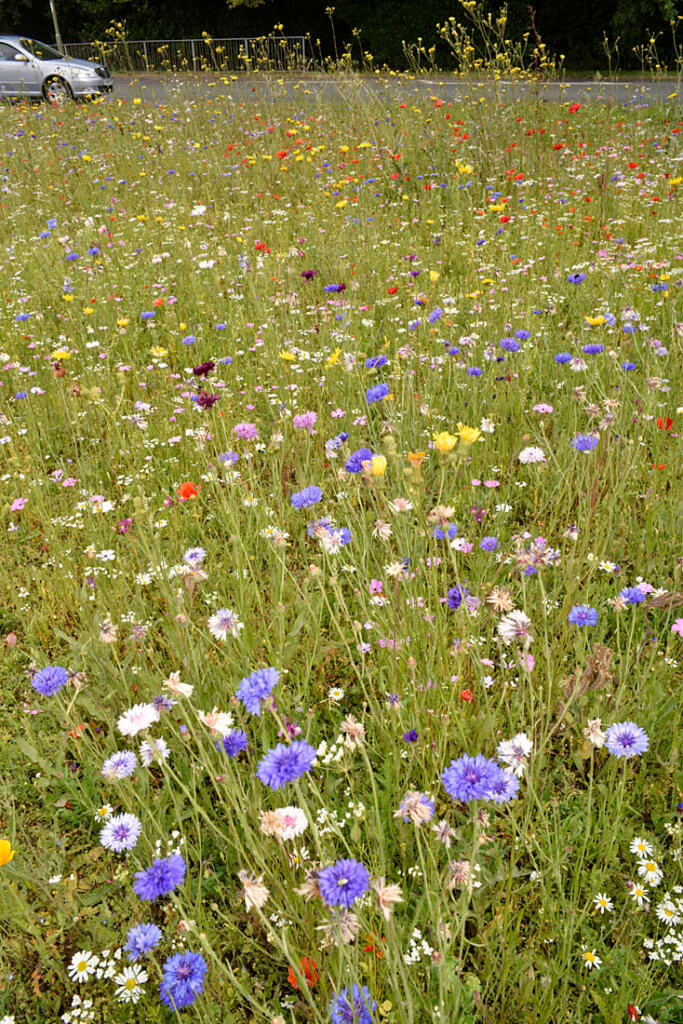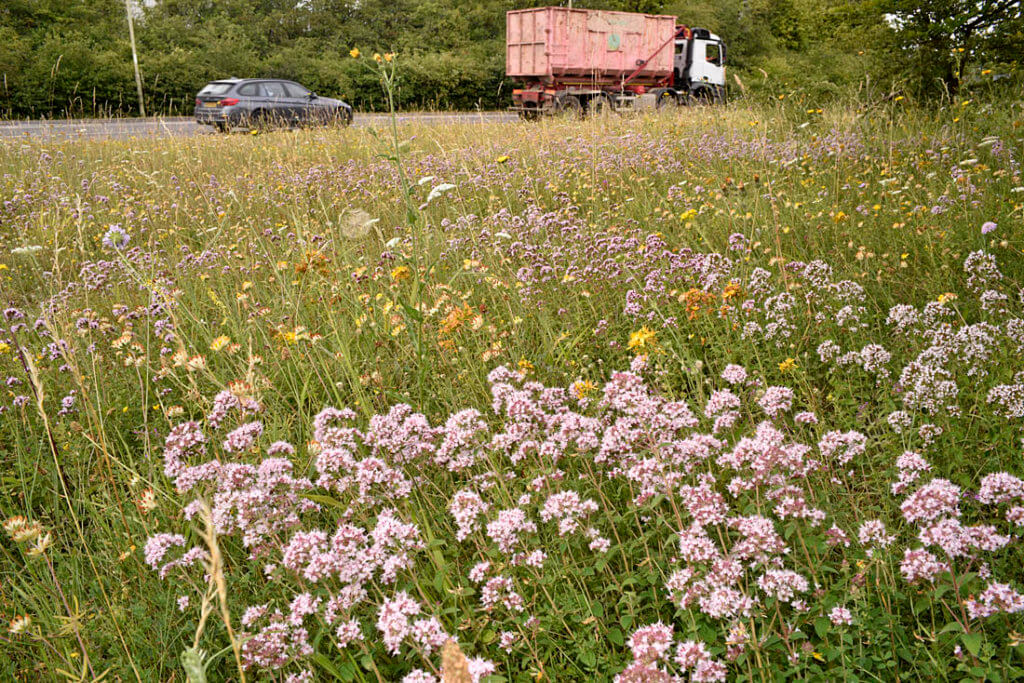
Paul Sterry has an academic background in freshwater biology and is a passionate conservationist. He has been writing about natural history and photographing wildlife for the last 40 years, with an emphasis on the British scene. He now has a string of beautifully illustrated guest blogs here.
Wildflower Verge or Colourful Eyesore?
I don’t regard myself as gardener but I am an occasional visitor to Yellow Book gardens and hence sometimes encounter the real thing. In these cultivated settings, it is not just the plants that are of interest of course, and as a keen observer of human nature the social niceties of horticultural life also entertain me. From a detached perspective I have noticed a tendency for true gardeners, particularly the sort that can afford to employ gardeners, to be rather sniffy about their peers, a behaviour that sometimes borders on horticultural snobbery. Cutting remarks are made with perfect manners of course, reminiscent of E.F. Benson’s ‘Mapp and Lucia’ books, and this trait seems especially true of those at what might be termed the Jekyllian end of the spectrum some of whom value muted colours above all else. Presumably it was just such a person that wrote a review I remember reading once that described a garden, rather uncharitably, as ‘an eyesore in purple, pink and orange’.
Getrude Jekyll, that pioneering gardener and floral powerhouse behind the Arts and Crafts movement, was all in favour of colour of course, both vibrant and muted. But she also valued harmony both in her planting schemes and her colour palette. With her Art School training behind her, and her colour wheel spinning, Jekyll worked on the basis that some colour schemes induced tranquillity while other more clashing combinations created discord, perhaps even raising blood pressure. So I wonder what she would make of the modern day trend for local councils to sow ‘wildflowers’ along verges bordering ringroads and dual carriageways. I am all for bringing colour into people’s lives but if Jekyll was right about the effect that colour has on mood then I wonder if these occasionally garish plantings encourage relaxed and considerate driving, or perhaps quite the opposite.
With the above in mind, the other day a friend sent me a link to an article in the Rotherham Advertiser, entitled ‘The story behind Rotherham’s bloomin’ lovely River of Colour’. https://www.rotherhamadvertiser.co.uk/news/view,feature-the-story-behind-rotherhams-bloomin-lovely-river-of-colour_32425.htm Subsequently I have seen the same scheme mentioned in glowing terms by the BBC and in national newspapers. The story is one about a seemingly laudable aim to grow ‘wildflowers’ beside an otherwise uninteresting 8-mile stretch of road. What could be wrong with that? Colour combinations notwithstanding the photograph used to illustrate the article showed a strange mix of former arable ‘weeds’ – just the sort of thing that intensive arable farmers want to be rid of – and a scattering of alien species and dubious natives . From what I could make out, the main components comprised a form of European poppy Papaver sp., California Poppy Eschscholzia californica, Cornflower Centaurea cyanus and Corn Marigold Glebionis segetum, all of which are plants of disturbed ground hence their liking for tilled farmland soils. How will they maintain this peculiar species mix I wondered? All was revealed when I read on to the section that stated “Hopefully in late March 2015 we will weed kill all of the eight miles and reseed it again in April”. That explained all. I am a bit confused about the dates I should add, because the article appeared in The Rotherham Advertiser in 2019 (according to my link) but the text refers to 2015.

Assuming the newspaper’s report was accurate the reality in the case of Rotherham was that native wildflowers (as well as the sown ones) were destined to be killed so the cycle could continue and inappropriate and occasionally alien (but colourful) species could charm the eyes of passing motorists. A victory for those producing and selling the seeds to councils perhaps but not so much for native biodiversity. Talking of financial benefits, the article stated that ‘At this time the council was spending around £80,000 on cutting the eight miles of grass, seven times a year, with outside contractors providing traffic management when the roads were closed to allow the work to take place.’ It went on to say that the man in charge believed ‘bringing it back inhouse and planting the wildflowers would bring back some colour and interest to the A631 Bawtry Road and A630 Centenary Way reservations’. He also felt that ‘having the wild flowers would reduce the amount of times the council would have to cut the reservations as it would be less dense than grass and so visibility for motorists would be better.’ And the article added ‘we’ve now saved £20,000 for the grounds maintenance budget.’

In these times where councils are facing austerity measures I have a suggestion. Unless road safety is an issue, let genuinely native wildflowers naturally colonise your roadside verges for free and cut the vegetation just once a year – in August or early September perhaps. And an extra tip would be to sow the seeds of Yellow-rattle Rhinanthus minor. This self-seeding plant is a semi-parasite of grasses and great for inhibiting their growth, as well as being colourful in its own right. Councils would save a huge amount of money and the result might actually benefit native biodiversity. Admittedly the verges would not be gaudily colourful but I think Getrude Jekyll would approve of that. The real point is that there’s a greater chance that the verges might then do something positive for native wildlife.

It is all of a piece with many people’s knee-jerk reaction not to let the natural world do it’s own thing, perhaps with a little gentle guidance from us. Horrific to regard anything that grows of it’s own accord a weed which has to be killed off. What is people’s problem?
Agreed Mr Sterry , Given the many thousands of miles of roadside verges the lunacy that is verge cutting should be seriously considered. Allow our native wildflowers to grow without interference, save a fortune and stop closing lanes to traffic, as far as re-seeding with corn field annuals with a foreign provenance simply daft. cornfield annuals need to be cultivated err annually to set seed
Yes, a roadside verge management strategy that is based on annual spraying of the verge with weedkiller to kill everything off seems to be utter madness.
Another timely blog Paul. I know people who’ve been disappointed with real wildlife meadows because they’re not ‘colourful’ enough, and these garish creations being put in to replace ‘ugly’ docks, nettles and bramble rather than close mowed grass. Hardly the big step for conservation they’re touted as. Use of non European alien flowers (at least European ‘aliens’ like fox and cubs co exist with our species on the continent) is pretty shocking and is it technically legal? At least as verges they run next to scrub in the form of hedging so there’s a bit of structural diversity. It’s the big hay meadow type ones I think are short changing us in terms of conservation. Uniformly grazed or cut they’re missing the little features you’re supposed to have to create habitat diversity in wildlife gardens – patch of perennial ‘weeds’, log pile, woodland edge and a wee pond. I’d love to see a policy that any conservation grassland over a certain size should incorporate a pond(s). That would make one hell of a contribution to raising biodiversity value. Bit of scrub and a planted tree or two for future wood pasture wouldn’t hurt either. The RSPB aims for its chalk grassland to incorporate 5% scrub now which is great. I worry these ‘wildflower’ meadows are really more like flowery lawns than the real habitat we need to be promoting, and the expectation is anything not as bright isn’t worth it. In parts of Stirling they deliberately left verges in residential areas uncut over summer. I thought they looked stunning even without many flowers in them, you can feel you’re walking along a country lane near the centre of a city. Many people didn’t like them until later in the year when the flowers bloomed though, close mowed grass still preferred to long, variegated vegetation without flowers. A tad disappointing re people’s attitudes? I’ve certainly got first hand experience of people wanting to put ornamental plants into woods, because woods didn’t have enough ‘colour’ – it can be a real hard battle to stop this. That to me was a deficiency on the part of those people not the wood and needed to be countered with stating nature should be appreciated for what it is, it’s not a bloody garden. So glad you’ve voiced your disquiet, the bar isn’t being set as high as it could or should be.
Thank you for this timely blog.
We should all be questioning our councils as to why our money is being wasted on this mania for neatness. At a time of austerity, cut back on the cutbacks, and at the same time, provide a counter to the destruction happening in our fields.
I believe I’m right in saying that Lincolnshire WT was the first in the country to promote wildlife verges, but even here, most of our verges, even the widest ones, are cut back to the hedge bottoms. Why? What does it achieve? It can’t be for safety reasons on a dead straight road.
Ok, so there may be a case for cutting the inside of bends, (god forbid anybody should just drive a little slower) but please cut with a little common sense.
There are huge savings to be made here across the country, what is not to like?
It has been my misfortune to have travelled much more than usual recently, particularly via Luton, Milton Keynes, Buckingham, Bedford and the like, with huge detours made because of the British Stink-Wheel Race. Even the Purple Cock of Towcester looks worn and dishevelled. The Saving Grace is the lining of many roads by unsown and uncut verges and vast numbers of Common Mallow and Red Campion. It has been a particularly good year for Viper’s Bugloss. But are the fly-tippers deterred by the height of the herbage, or is the litter is just hidden.
Surely removal of the post-seeding thatch would be far preferable to weed killing and I assume would be do-able with specialist machinery?
In year two, far fewer (corn field) annuals would appear and hopefully (native) perennials such as knapweed might begin to take over if such seed had also been in the mix…..
However, the ‘must be very colourful’ imperative is a difficult one to argue against especially when wildflowers replace and have to ‘compete’ with those garish bedding plantings so often seen on roundabouts etc.
As with the ‘tidiness is next to godliness’ mentality, I fear we face an uphill struggle to change attitudes on both counts….
Ps. It was heartening to see Gardener’s World last week (BBC 2, episode 18) devoting the whole programme to wildflower meadows. Even if some of the examples shown were of non-native mixes albeit mostly in garden settings, perhaps they are acceptable if not ideal. And a (non-native and ‘garish’) Pictorial Meadows mix used in a NT garden near me was drawing lots of bees and hoverflies when I visited it recently…..a definite plus point.
I really sympathise with your viewpoint, but ‘difficult to argue against’….when exactly? Few people or organisations seem to be trying to and that leaves the very vociferous ‘daffodils should be everywhere’ or ‘long grass is evil’ fraternity an easy run of it so perhaps we should be putting that to the test more. Those who are pushing for change are easily brushed off in my experience and just shrug their shoulders in acceptance when they should be pointing out they pay council tax too and are as entitled to see wildlife areas as other people are to see close mowed grass, it’s called democracy. We tend to fall just a bit shy of going to the media and saying how all young children love creepy crawlies, but none have been known to become enraptured with the fascination of close cut rye grass, so why is access to the former seriously curtailed for them by official policy? Our ignorance and fear of nature should be seen as an extension of the same dangerous ignorance we have about food production – that’s only the truth and we need to bang that drum more. I believe far more people want change than is realised, but as a group we tend to ‘Sit at the back of the bus’. A bit of passion from us for a change and we can stop and reverse the process that could one day see our ‘hedgerows’ comprised of hydrangeas if we don’t grow a bit of backbone, many are already flail mowed to pathetic ‘neat’ rectangles so that wouldn’t be such a big step.
And, of course there is a duty of care for biodiversity placed upon all Local Authorities, not that you would know if in most areas. The general standard of grassland management seems to take no account of biodiversity, it is typically lazy and over interventionist. At least some are just starting to take a little bit of notice of how much can be done and how much can be saved (wildlife and money).
Robert – many thanks for your first comment here.
Paul
As usual, a great blog.
Not being knowledgeable on this, please could you suggest some links that I can direct my local council towards.
Also, can you recommend any links for gardeners? Many thanks.